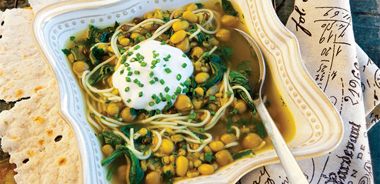Winter Soup with Beans and Leafy Greens (Ash-e-Reshteh)

We’ve adapted this delicious vegetarian soup and added a little barley to the angel hair noodles to make it a meal unto itself. The combination of fresh herbs makes it come alive. Top with dollops of plain yogurt and serve lavash (crisp flatbread) on the side.
1/2 cup (125 mL) dried chickpeas
1/2 cup (125 mL) dried navy beans
2 Tbsp (30 mL) extra-virgin olive oil
2 onions, minced
4 garlic cloves, minced
3 1/2 quarts (3.3 L) vegetable stock
1/2 cup (125 mL) pot barley, rinsed
1/4 cup (60 mL) dried lentils
1 tsp (5 mL) turmeric
4 oz (115 g) angel hair pasta
3 cups (750 mL) baby spinach leaves
1 large bunch fresh mint, chopped
1/2 cup (125 mL) each of minced cilantro and minced parsley
1/4 cup (60 mL) finely chopped fresh dill
Salt and pepper, to taste
2 cups (500 mL) thick plain yogurt
Minced fresh chives
Place dried chickpeas and navy beans in large colander. Sort through them and remove any tiny pebbles or other debris. Rinse under cold water and place in large, heavy saucepan with three times their volume of cold water. Bring them gently to a boil. Then remove saucepan from the heat and let beans soak uncovered for no more than 2 hours. Soaking beans too long causes them to ferment, which affects flavour and digestibility.
Meanwhile, heat oil in large frying pan. Add onions and garlic, and sauté until soft and golden, about 5 minutes. Set aside.
Once beans have soaked the recommended time, drain well and return to saucepan. Add vegetable stock and sautéed onions and garlic. Bring to a gentle boil, reduce heat to medium-low, cover and gently boil for 30 minutes. Stir in barley, lentils, and turmeric. Return to a gentle boil and cook covered for another 30 minutes to 1 hour.
Beans are done when you can easily mash with a fork. Don’t worry about the foam, as it will be reabsorbed into the liquid. Stir occasionally. For a creamier texture, use a hand-held emulsifier and purée soup for a few seconds.
Stir in pasta and return to a gentle simmer, with lid slightly ajar for another 15 minutes or until pasta is tender to the bite. Add spinach and herbs, and cook for 2 to 5 minutes or until soft. Add salt and pepper to taste.
Serve with dollops of thick white yogurt and a sprinkling of fresh chives.
Serves 8.
Each serving contains: 301 calories; 15 g protein; 7 g total fat (2 g sat. fat, 0 g trans fat); 49 g total carbohydrates (8 g sugars, 11 g fibre); 148 mg sodium
source: "Persian Cuisine", alive #377, March 2014





